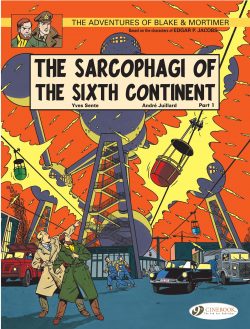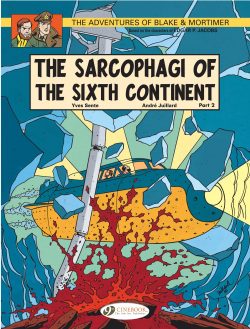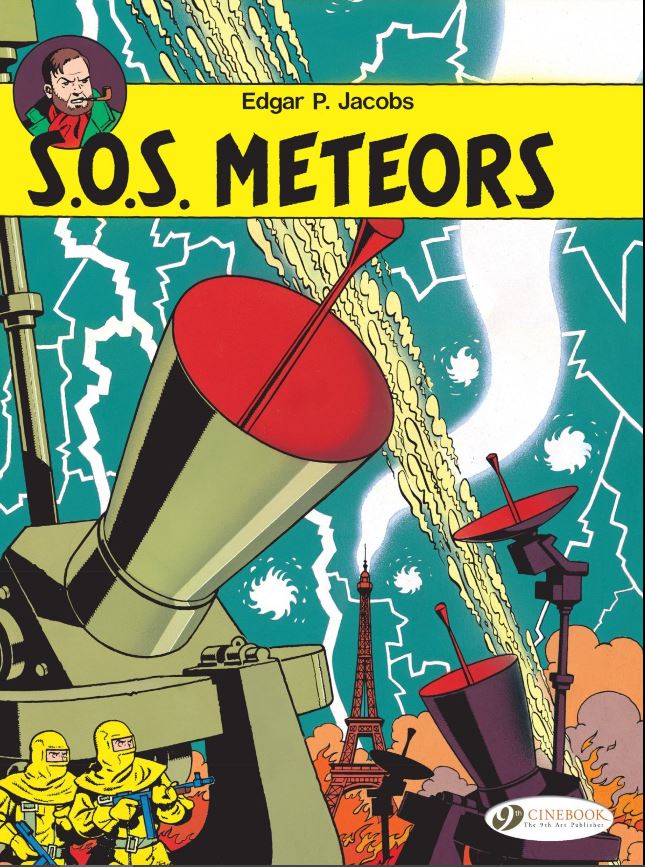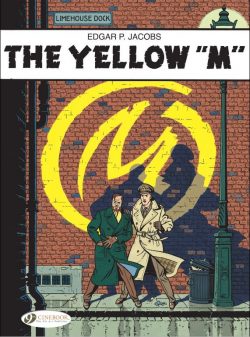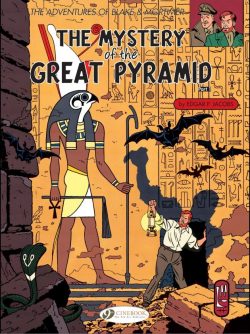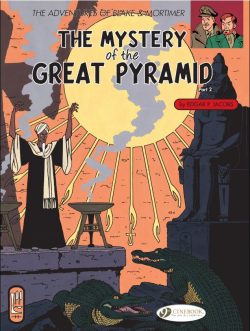
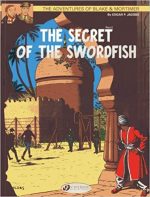

By Edgar P. Jacobs, coloured by Philippe Biermé & Luce Daniels, translated by Jerome Saincantin (Cinebook)
ISBNs: 978-1-84918-148-8, 978-1-84918-161-7 and 978-1-84918-174-7
Belgian Edgard Félix Pierre Jacobs (1904-1987) is rightly considered one of the founding fathers of the Continental comics industry. Although his output is relatively meagre when compared to some of his contemporaries, the iconic series he worked on formed the basis and backbone of the art-form in Europe, and his splendidly adroit, roguish and impeccably British adventurers Blake and Mortimer, created for the first issue of Le Journal de Tintin in 1946, swiftly became a staple of post-war European kids’ life the way Dan Dare would in Britain in the 1950s.
Edgar P. Jacobs was born in Brussels, a precocious child who began feverishly drawing from an early age but was even more obsessed with music and the performing arts – especially opera. He attended a commercial school but – determined never to work in an office – pursued art and drama following his graduation in 1919.
A succession of odd jobs at opera-houses – scene-painting, set decoration, acting and singing as an Extra – supplemented his private performance studies, and in 1929 Jacobs won a Government award for classical singing. His proposed career as an opera singer was thwarted by the Great Depression, however, as the arts took a nosedive following the stock market crash.
Picking up whatever stage work was going – including singing and performing – Jacobs switched to commercial illustration in 1940. Regular employment came from the magazine Bravo. While illustrating short stories and novels, he famously took over the syndicated Flash Gordon strip, after the occupying German authorities banned Alex Raymond’s quintessentially All-American Hero and left the publishers desperately seeking someone to satisfactorily complete the saga.
Jacob’s Stormer Gordon lasted less than a month before being similarly sanctioned by the Nazis, after which Jacobs created his own epic science-fantasy feature in the legendary Le Rayon U: a milestone in both Belgian comics and science fiction adventure.
The U Ray was a huge hit in 1943 and scored big all over again a generation later when Jacobs reformatted the original “text-block and picture†material to incorporate speech balloons and re-ran the series in Le Journal de Tintin with subsequent releases as a trio of graphic albums in 1974.
I’ve read differing accounts of how Jacobs and Tintin creator Hergé got together – and why they parted ways professionally, if not socially – but as to the whys and wherefores of the split, I frankly don’t care. What is known is this: whilst creating the weekly U Ray, one of Jacob’s other jobs was scene-painting, and during the staging of a theatrical version of Tintin and the Cigars of the Pharaoh Hergé and Jacobs met and became friends. If the comics maestro was unaware of Jacob’s comics output before then, he was certainly made aware of it soon after.
Jacobs began working on Tintin, colouring the original monochrome strips of The Shooting Star from newspaper Le Soir for a forthcoming album collection. By 1944, Jacobs was performing similar service for Tintin in the Congo, Tintin in America, King Ottokar’s Sceptre and The Blue Lotus. By now, he was also contributing to the illustration as well, on extended epic The Seven Crystal Balls/Prisoners of the Sun.
Jacob’s love of opera made it into the feature as Hergé (who loathed the stuff) teasingly created bombastic Bianca Castafiore as a comedy foil and based a number of bit players (such as Jacobini in The Calculus Affair) on his long-suffering assistant.
After the war and liberation, publisher Raymond Leblanc convinced Hergé, Jacobs and a number of other creatives to work for his new venture. Launching publishing house Le Lombard, he also started Le Journal de Tintin, an anthology comic edited by Hergé, with editions in Belgium, France and Holland starring the intrepid boy reporter and a host of newer heroes.
Beside Hergé, Jacobs and writer Jacques van Melkebeke, the comic featured Paul Cuvelier’s Corentin and Jacques Laudy’s ‘The Legend of the Four Aymon Brothers’. Laudy had been a friend of Jacobs’ since they worked together on Bravo, and the first instalment of epic thriller serial ‘Le secret de l’Espadon’ starred a bluff, gruff British scientist as well as an English Military Intelligence officer closely modelled on Laudy: Professor Philip Mortimer and Captain Francis Blake…
The story ran from issue #1 (26th September 1946 to 8th September 1949): cementing Jacobs’ status as a star in his own right. In 1950, with the first 18 pages slightly redrawn, Le secret de l’espladon V1 (The Secret of the Swordfish) became Le Lombard’s first album release; with the concluding part published three years later. The volumes were reprinted nine more times between 1955 and 1982, with an additional single complete deluxe edition released in 1964.
In 1984 the story was reformatted and repackaged in English translation as three volumes with additional material (mostly covers from the weekly Tintin added to the story as splash pages) as part of a European push to win some of Britain’s lucrative Tintin and Asterix market, but failed to find an audience and ended after seven volumes.
Happily, Cinebook have successfully introduced us to the dashing duo – albeit after publishing the later adventures first – and you can revel in the wonderment in either paperback album or eBook formats…
Hergé and Jacobs purportedly suffered a split in 1947 when the former refused to grant the latter a by-line on new Tintin material, but since they remained friends for life and Jacob’s continued to produce Blake and Mortimer for the Belgian weekly, I think it’s fair to say that if such was the case it was a pretty minor spat.
I rather suspect that The Secret of the Swordfish was simply taking up more and more of the brilliant, diligent artist’s time and attention…
The U Ray also provided early visual inspiration for Blake, Mortimer and implacable nemesis Colonel Olrik, who bear a more than passing resemblance to heroic Lord Calder, Norlandian boffin Marduk and viperous villain Dagon from that still lauded masterwork – one that is also well overdue for translation…
One minor word of warning: by having the overarching enemies of mankind be a secret Asiatic “Yellow Peril†empire of evil, there’s some potential for offence – unless one actually reads the text and finds that the assumed racism is countered throughout by plenty of “good†ethnic characters and “evil†white folk…
The Secret of the Swordfish Part 1 – Ruthless Pursuit
The incredible journey begins with ‘The Incredible Chase’ as a secret army in the Himalayas prepares to launch a global Blitzkrieg on a world slowly recovering from its second planetary war. The wicked Basam Damdu, Emperor of Tibet, has assembled an arsenal of technological super-weapons and the world’s worst rogues such as insidious Colonel Olrik in a bid to seize control of Earth.
However, a bold British-Asian spy has infiltrated the hidden fortress and surrenders his life to get off a warning message…
In England, physicist and engineer Philip Mortimer and MI5 Captain Francis Blake discuss the worsening situation at an industrial installation where the boffin’s radical new aircraft engine is being constructed. When the warning comes that the war begins that night, the old friends swing into immediate action…
As the super-bombers rain destruction down on all the world’s cities, Mortimer’s dedicated team prepares his own prototype, the Golden Rocket, for immediate launch, taking off just as Olrik’s bombers appear over the desolate complex. Despite heavy fire, the Rocket easily outdistances the rapacious Imperial forces, leaving ruined homes in its wake as the fleeing Britons fly into a hostile world now brutally controlled by Basam Damdu…
Whilst seeking to join British Middle East resistance forces who have another prototype super-plane, teething troubles and combat damage create tense moments in the fugitives’ flight. When the Rocket is attacked by a flight of jets, the test ship’s superior firepower enables it to fight free, but only at the cost of more structural deterioration.
Failing now, the Rocket goes down in the rocky wilds between Iran and Afghanistan. Parachuting free of the doomed Rocket, Blake, Mortimer and the crew are machine-gunned by pursuing Empire jets and only three men make it to the ground safely…
After days of struggle Blake, Mortimer and the indomitable Jim are cornered by Iranian troops who have joined Olrik’s forces. Sensing disaster, the Britons hide the plans to Mortimer’s super-plane but one of the Iranians sees the furtive act. When no one is looking – especially his superiors – Lieutenant Ismail hurriedly scoops up the documents, but misses one…
Under lock and key and awaiting Olrik’s arrival, the prisoners are accosted by Ismail, who sees an opportunity for personal advancement which the Englishmen turn to their own advantage. Denouncing him to his superiors, Blake instigates a savage fight between Ismail and his captain. During the brief struggle Jim sacrifices himself, allowing Blake and Mortimer to escape with the recovered plans. Stealing a lorry, the desperate duo drive out into the dark desert night…
Followed by tanks into the mountain passes, the ingenious pair trap their pursuers in a ravine just as hill partisans attack. The Imperial collaborators are wiped out and, after exchanging information with the freedom fighters, the Englishmen take one of the captured vehicles to a distant rendezvous with the second Rocket. Lack of fuel forces them to stop at a supply dump where they are quickly discovered.
By setting the dump ablaze the heroes escape again, but in the desert Olrik has arrived and finds the sheet of notes left behind by Ismail. The cunning villain is instantly aware of what it means…
Fighting off aerial assaults from Empire jets and streaking for the mountains, Blake and Mortimer abandon their tank. Forced to travel on foot, they at last reach the meeting point where British-trained Sergeant Ahmed Nasir awaits them. The loyal Indian served with Blake during the last war and is delighted to see him again, but as the trio make their way to the target site, they become aware that Olrik has already captured their last hope…
Only temporarily disheartened, the trio use commando tactics to infiltrate Olrik’s camp, stealing not the heavily-guarded prototype but the villainous Colonel’s own Red-Wing super-jet. Back on course to the British resistance forces, the seemingly-cursed trio are promptly shot down by friendly fire: rebels perceiving the stolen plane as another enemy target…
Surviving this crash too, the trio are ferried in relative safety by the apologetic tribesmen to enemy-occupied town Turbat, but whilst there a spy of the Empire-appointed Wazir recognises the fugitive Englishmen. When Nasir realises they are in trouble, he dashes to the rescue but is too late to prevent Mortimer from being drugged.
Sending the loyal Sergeant on ahead, Blake tries frantically to revive his comrade, even as Imperial troopers rapidly mount the stairs to their exposed upper room…
To Be Continued…
This Cinebook edition includes a tantalising preview of the next volume as well as stand-alone adventure The Yellow “Mâ€, plus biographical features and chronological publication charts.
Volume 16: The Secret of the Swordfish Part 2 – Mortimer’s Escape
This second instalment carries the tale to the next epic level, as the frantic action resumes with soldiers bursting into an empty chamber before being themselves attacked by the Khan. After a bloody firefight the Englishmen emerge from their cunning hiding place and flee Turbat, which has been seized by a furious spur-of-the-moment rebellion.
Unknown to the fugitives, devious spy Bezendjas is hard on their heels and soon finds an opportunity to inform Olrik. With the city in flames and fighting in every street, the callous colonel abandons his own troops to pursue Nasir, Blake and Mortimer into the wastes beyond the walls…
On stolen horses the heroes endure all the ferocious hardships of the desert, but cannot outdistance Olrik’s staff-car. After days of relentless pursuit, they reach the rocky coastline and almost stumble into another Empire patrol. Whilst ducking them, Blake nearly falls to his doom…
Narrowly escaping death, the trio continue to climb steep escarpments and it is dusk before the Intelligence Officer realises that he has lost the precious plans and documents they have been carrying since fleeing England…
Realising that somebody must reach the British resistance at their hidden Eastern base, the valiant comrades split up. Blake and Nasir continue onwards whilst Mortimer returns to the accident site. Finding the plans is a stroke of sheer good fortune, immediately countered by an ambush from Olrik’s troops. Despite a Herculean last stand, the scientist is at last taken prisoner but only after successfully hiding the lost plans…
Three months later, Olrik is called to account in the exotic city-fortress of Lhasa. Basam-Damdu’s ruling council are unhappy with the Colonel’s lack of progress in breaking the captive British scientist, and even more infuriated by a tidal-wave of sabotage and armed rebellion throughout their newly-conquered territories. Even Olrik’s own spies are warning him that his days as an agent of the Yellow Empire are numbered…
Given two days to make Mortimer talk, the Colonel returns to his base in Karachi just as another rebel raid allows Nasir to infiltrate the Empire’s HQ. Blake is also abroad in the city, having joined British forces in the area…
With less than a day to act, the MI5 officer rendezvous with a British submarine and travels to a vast atomic-powered secret installation under the Straits of Hormuz. Here, the Royal Navy are stoically preparing for a massive counter-attack on the Empire. With raids liberating interned soldiers all the time, the ranks of scientists, technicians and soldiers are swelling daily…
Meanwhile, Nasir has his own desperate plan to free Mortimer, who is still adamantly refusing to talk of the mysterious “Swordfish†Olrik’s agents continually hear rumours of…
Aware of his danger and the Sergeant’s efforts, Mortimer instead cunningly informs Nasir of the lost plans’ location, even as the impatient Emperor’s personal torturer arrives from Lhasa…
Always concerned with the greater good, Blake and a commando team secure the concealed plans and are met by Nasir who has been forced from Karachi after realising Bezendjas has recognised him. It appears that time has run out for their scholarly comrade…
Mortimer, however, has taken fate into his own hands. When the devious doctor Sun Fo begins his interrogation, the Professor breaks free and escapes into the fortress grounds during an earth-shattering storm.
Trapped in a tower with only a handgun, he is determined to sell his life dearly, but is rescued by Blake and Nasir in a Navy Helicopter. Using the storm for cover, the heroes evade jet pursuit and an enemy naval sweep to link up with a British sub and escape into the night…
To Be Concluded…
This edition includes a preview of the next volume and excerpts from stand-alone saga S.O.S. Meteors, plus the usual biography features.
Volume 17: The Secret of the Swordfish Part 3 – SX1 Strikes Back!
After three years of stunning intrigue, mystery and action, E.P. Jacobs’ groundbreaking saga of a battle for world peace and universal liberty concluded in a spectacular duel below the Earth and in the skies of the embattled world. SX1 Strikes Back! is a tension-drenched race against time as Blake, Mortimer and the shattered dregs of Great Britain’s military forces prepare for a last-ditch strike using the Professor’s greatest inventions to win freedom for the oppressed peoples of Earth…
The final chapter opens with a stunning reprise of past events – cunningly compiled from a succession of six full-page illustrations (presumably original covers from weekly Le Journal de Tintin) – after which a daring commando raid liberates a trainload of British prisoners.
Brought to a fabulous subterranean fortress, the assorted scientists and engineers discover an underground railway, factory, armaments-facilities and even an atomic pile, all furiously toiling to complete the mysterious super-weapon dubbed “Swordfishâ€.
The former prisoners readily join the volunteers, blithely unaware that supremely capable scoundrel Olrik is amongst them in devilish disguise…
Days pass and as preparations for the Big Push produce satisfactory results, a series of disastrous accidents lead to one inescapable conclusion: there is a saboteur in the citadel…
Eventually Olrik becomes overconfident and Mortimer exposes the infiltrator in a crafty trap, but after a fraught confrontation the Colonel escapes after almost causing a nuclear catastrophe. Fleeing across the seabed, the harried spy narrowly avoids capture by diver teams and a hungry giant octopus…
The flight takes its toll upon Olrik and he barely reaches land alive. Luckily for him, Bezendjas has been checking out the region of coastline and finds the exhausted villain trapped in his stolen deep-sea suit. After a lengthy period, the dazed desperado recovers and delivers his hard-won information. Soon, Imperial forces are converging on the British bastion…
As air and sea forces bombard the rocky island and sea-floor citadel, Olrik dispatches crack troops to break in via a concealed land entrance, resulting in a staggering battle in the depths of the Earth.
They were almost in time…
After months of desperate struggle, Mortimer and his liberated scientists have rushed to complete the incredible Swordfish: a hypersonic attack jet with uncanny manoeuvrability and appallingly destructive armament.
Astoundingly launched from beneath the sea, the sleekly sinister plane single-handedly shoots the Empire jets out of the skies before sinking dozens of attacking ships. Ruthlessly piloting SX1 is Francis Blake; and even as he wreaks havoc upon the invading force, he is joined by SX2 -a second, equally unstoppable super-jet…
Soon the Yellow Empire is in full retreat and a squadron of Swordfish is completed. With the once-occupied planet in full revolt, it’s not long before Lhasa gets a taste of the flaming death it callously inflicted upon a peaceful, unsuspecting and now extremely vengeful world…
They are only just in time: the insane and malignant Emperor is mere moments away from launching a doomsday flight of atomic missiles to every corner of the planet he so briefly owned…
This Cinebook edition also includes fascinating illustrated essay ‘Jacobs: 1946, The Swordfish, starting point of a masterful work’, first seen in The World of Edgar P. Jacobs, a tantalising preview of later epic The Oath of the Five Lords (by Yves Sente & André Juillard) plus a biographical feature and chronological publication chart of Jacobs’ and his successors’ efforts.
Gripping and fantastic in the truest tradition of pulp sci-fi and Boy’s Own Adventures, Blake and Mortimer are the very epitome of dogged, heroic determination; always delivering grand, old-fashioned Blood-&-Thunder thrills and spills in timeless fashion and with astonishing visual punch.
Despite an epic body count and dated milieu, any kid able to suspend modern mores and cultural disbelief (call it alternate Earth history or bakelite-punk if you want) will experience the adventure of their lives… and so will their children.
Original editions © Editions Blake & Mortimer/Studio Jacobs (Dargaud – Lombard S.A.) 1984, 1985, 1986 by E.P. Jacobs. All rights reserved. English translation © 2012, 2013 Cinebook Ltd.



